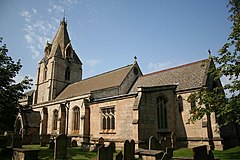Mansfield Woodhouse
| Mansfield Woodhouse | |
|---|---|
 Saint Edmund's Parish Church |
|
| Mansfield Woodhouse shown within Nottinghamshire | |
| OS grid reference | SK540632 |
| District | |
| Shire county | |
| Region | |
| Country | England |
| Sovereign state | United Kingdom |
| Post town | MANSFIELD |
| Postcode district | NG19 |
| Dialling code | 01623 |
| Police | Nottinghamshire |
| Fire | Nottinghamshire |
| Ambulance | East Midlands |
| EU Parliament | East Midlands |
| UK Parliament | |
Mansfield Woodhouse is a large village about 1.2 miles (2 km) north of Mansfield in Nottinghamshire, England, stretching alongside the main A60 road in a wide, low valley between the Rivers Maun and Meden. With a history dating back before the Roman Empire, it is still noteworthy for its stone-built town centre.
Mansfield Woodhouse was an entity with its own urban district council but after continuous development, it has become a large section within the Mansfield Urban Area. Following a change in local government structure on 1 April 1974, Mansfield Woodhouse and Warsop Urban District Councils merged with the municipal borough of Mansfield to form a new local government district, Mansfield District.
Mansfield Woodhouse's economy was traditionally based on quarrying, mining, farming and textile industries.
The Romans had a fortress and a civilian settlement in the area (remains of a Roman villa were famously found here by Hayman Rooke in the 1780s). The area declined after the Romans left but by the 13th century, there was a growing settlement of smallholders.
On 12 September 1304, fire destroyed the village, including its timber-framed church. The town was rebuilt using local materials and the new stone-built church, dedicated to St. Edmund, still stands.
The village recovered and by Tudor times, was home to a number of wealthy families. Farming and quarrying were the main livelihoods and Mansfield Woodhouse also prospered with the growth of the textile and hosiery trades into the 19th century.
One thing not commonly known about Mansfield Woodhouse is that locally quarried stone was used to build the Houses of Parliament.
...
Wikipedia

